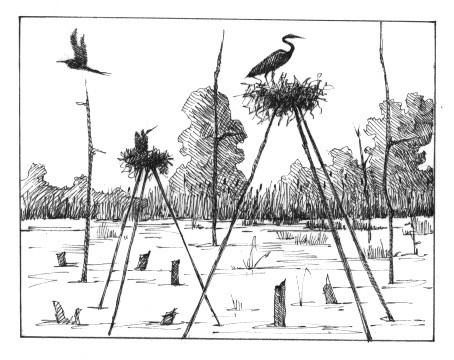
We could hear the pond before we could see it. The shrill “oak-a-ree” of red-winged blackbirds could be heard well into the surrounding forest. Closer to the pond, the loose banjo-string call of a green frog joined in. A few steps later we heard the bullfrogs, sounding like a jug band chorus.
The adult herons flew off the moment Wally Elton, our group’s leader, stepped into the clearing. When I entered, the first thing I noticed were two heron fledglings standing tall in their nest of sticks built on a spindly human-made tripod in the middle of a long-abandoned beaver pond. The fledglings were about two and a half feet tall, and their grayish feathers matched the weathered wood of the tripod and their stick nest.
Great blue herons are big birds. The adults can be over four feet tall and have a wingspan of nearly six feet. It makes sense that their fledglings are similarly large. Great blue herons prefer to breed in secluded wetlands, away from their usual feeding grounds, and they have found just such a place in Weathersfield, Vermont, in an old beaver pond surrounded by forest.
The Ascutney Mountain Audubon Society has had its eye on this place for about 15 years, monitoring the number of great blue heron nests and fledglings each year. The annual monitoring is what brought Elton (Ascutney Mountain Audubon’s vice president), some of its board members, and me to the heronry—which is also called a heron rookery or colony.
In 1992 this heronry reached a peak of 12 nests, but the monitors noticed that the dead pines supporting the nests were beginning to fall. When the number of nests plummeted to six the next year, the Society took action. They worked with the Vermont Department of Fish and Wildlife to erect two tripods to provide alternative nest sites. This year Elton counted 13 great blue heron fledglings in six nests built on four of the five tripods now at the site. Last year there were five nests and 15 fledglings.
Great blue heron numbers declined severely in the 1960s and 1970s when DDT, a chemical intended to control mosquito larvae, caused the shells of heron eggs to thin and crack before the chicks were able to survive. With DDT now banned in the United States, herons are so numerous that there hasn’t been an official study of heron breeding sites in Vermont in about 15 years, says Everett Marshall, a nongame biologist with the Vermont Department of Fish and Wildlife. Marshall suspects there may be as many as 100 heronries in Vermont.
The great blue heronries of New Hampshire have been studied in more depth and more recently. A 10-year study by the Audubon Society of New Hampshire was completed in 1992, when there were 123 active heronries. The time-consuming and difficult-to-fund study ended, explains Chris Martin, senior biologist with Audubon Society of New Hampshire, when it became clear that the heron population was quite stable.
While the number of nests and fledglings in the Weathersfield heronry varies little, the beaver pond itself is decisively changing from pond to marsh. Elton pointed out that one of the tripods is now on dry ground, and is unattractive as a heron nesting site because predators have an easier time accessing the nests.
While heronries are found in several kinds of wetlands, Martin said that herons have a special – if temproary – relationship with beaver ponds containing standing dead trees. “The problem is these trees decay over time,” Martin said. “The beavers abandon the pond, the pond dries out, and it’s not useful to the herons anymore.” This is exactly what is happening in Weathersfield.
The herons, though, don’t seem to have a problem moving around the landscape, following the beavers. Martin feels that as long as beavers are still out there, the herons will have a place to breed.
Meanwhile, osprey are following the herons. New England’s osprey population was also hit hard during the DDT years, and is still recovering. In the last few years, more than half of the 15 or 20 new nesting pairs of ospreys found in southern New Hampshire have been in heronries. Though osprey and herons both eat fish (herons eat frogs, reptiles and small mammals too), the two species coexist peacefully, perhaps because both travel away from the nesting area to get food for themselves and their young.
Ospreys don’t nest in the Weathersfield heronry, although the unused platform-on-a-pole provides just the kind of nesting site they might like. For now the herons have the frogs and the blackbirds for company, as well as cattails, blue flag iris, and ferns as the pond dries out. As our group prepared to leave the heronry, a swarm of electric-blue damselflies flitted over the ferns, and the jug band chorus started up again.


Discussion *